INTRODUCTION
Glenohumeral joint is a common site for injury, which accounts for >30% of all injuries in overhead athletes [
1]. According to a domestic study, glenohumeral joint injury accounts for nearly 65% of all injuries among Korean teenage baseball players [
2]. High school baseball players are exposed to risks through excessive training and a large number of games, due to the pressure of getting accepted into the elite schools or teams. Moreover, the lack of recognition of an injury is a risk factor for even further injury, through aggravation of the previous injury which was not treated appropriately [
3]. Repeated pitching elicits changes in the joint of the throwing shoulder (T-shoulder), including increased external rotation (ER) and decreased internal rotation (IR), compared to the non-throwing shoulder (NT-shoulder) [
4,
5,
6]. The difference of ≥20° in the range of motion (ROM) in IR between the T-shoulder and the NT-shoulder is known as glenohumeral internal rotation deficit (GIRD) [
7,
8]. GIRD is a major risk factor for glenohumeral joint injury in baseball players [
7,
9,
10,
11]. GIRD causes humeral retroversion, hyperplasia of the joint capsule, and muscular stiffness; and it induces imbalance in the soft tissues of the shoulder joint, which results in subacromial and intrinsic impingement syndromes [
8,
12]. Wilk et al. [
10] reported that the incidence of glenohumeral joint injury is twice as high in baseball players with GIRD, as in those without GIRD. The incidence of GIRD is known to be closely associated with the number and period of overhead throws. In a 10-year study by Fleisig et al. [
13] on the pitchers who had thrown more than 100 innings in a year, 5% of these pitchers were reported to have sustained severe damage and that limiting the number of pitches can reduce the damage. A baseball player is at the risk of shoulder ROM deformation, pain, or damage throughout his career, due to the nature of the sport. As a result of these changes, GIRD may negatively affect the playing span of a baseball player. Although research regarding GIRD has been previously conducted, the associations between the degree of GIRD and shoulder pain and isokinetic strength have not been previously investigated for Korean teenagers, who have not yet reached their full growth potential. Therefore, in the present study, we aimed to determine the degree of GIRD in high school baseball players in Korea and investigated its association with body pain (including shoulder pain), shoulder isokinetic strength, and quality of life.
Go to :

RESULTS
For all subjects, the mean value of ER ROM was significantly higher for the T-shoulder (108.21°±10.52°) than for the NT-shoulder (99.12°±9.55°) (p<0.001). The IR ROM was significantly lower for the T-shoulder (39.25°±15.29°) than for the NT-shoulder (48.57°±12.81°) (p<0.001). The proportion of individuals with GIRD (12/56 study subjects) was 21.43%. The mean difference in IR ROM, between the NT-shoulder and T-shoulder, was 25.75°±1.21° in group A and 4.20°±11.6° in group B.
With regard to the ROM of the glenohumeral joint in group A, the mean ER ROM was 106.92°±11.37° in the T-shoulder and 95.67°±10.26° in the NT-shoulder, whereas the mean IR ROM was 29.25°±12.98° in the T-shoulder and 55.00°±11.77° in the NT-shoulder. In group B, the mean ER ROM was 108.57°±10.39° in the T-shoulder and 100.07°±9.25° in the NT-shoulder, whereas the mean IR ROM was 41.98°±14.77° in the T-shoulder and 46.82°±12.63° in the NT-shoulder (
Table 2).
Table 2
The mean differences in the shoulder range of motion and glenohumeral internal rotation deficit between groups A and B
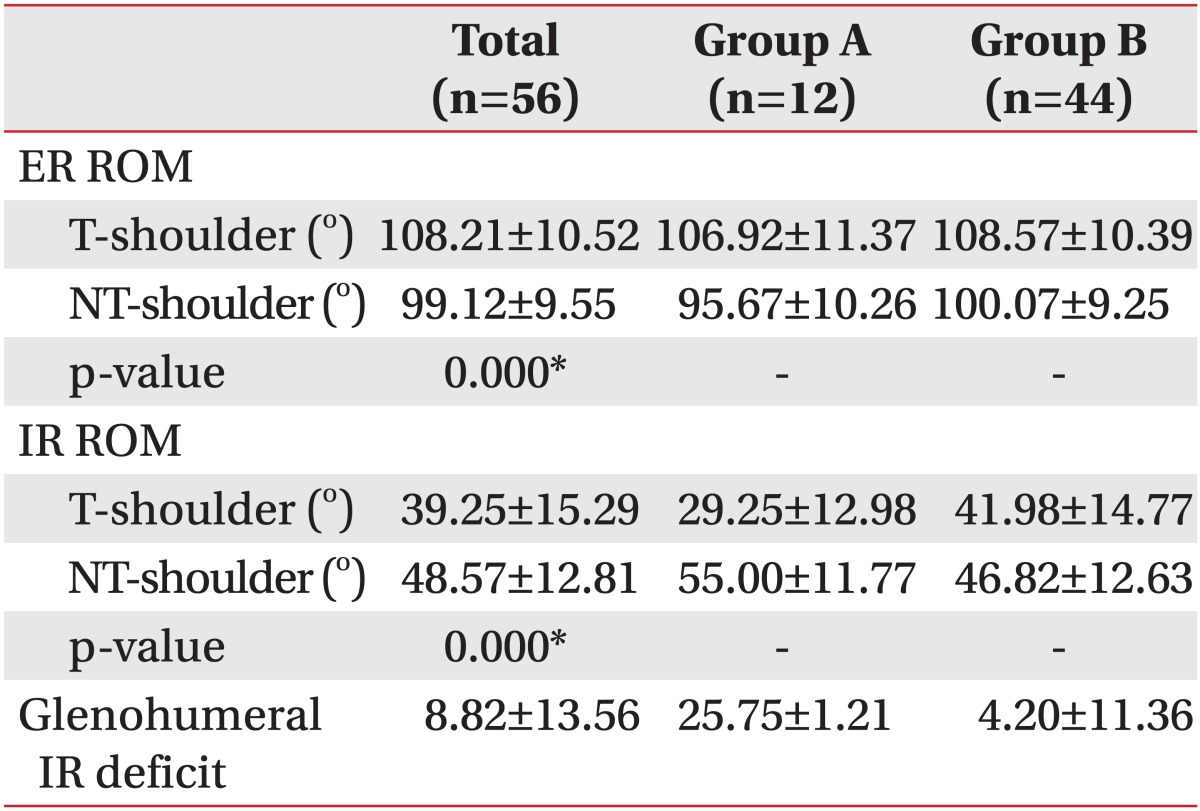

With regard to the isokinetic strength, at an angular velocity of 60°/s, the flexion in groups A and B was 73.75±12.08 N/m and 77.70±9.59 N/m, respectively, whereas the extension in groups A and B was 94.50±12.32 N/m and 95.91±11.41 N/m, respectively. At an angular velocity of 180°/s, the flexion in groups A and B was 73.83±8.41 N/m and 80.32±9.21 N/m, respectively, whereas the extension in groups A and B was 99.75±8.34 N/m and 105.84±9.75 N/m, respectively (
Table 3). Increasing severity of GIRD was significantly and negatively correlated with isokinetic strength (p<0.001; correlation coefficient [CC], -0.43 to -0.19).
Table 3
The mean difference in isokinetic strength of the throwing shoulder between groups A and B (unit, N/m)
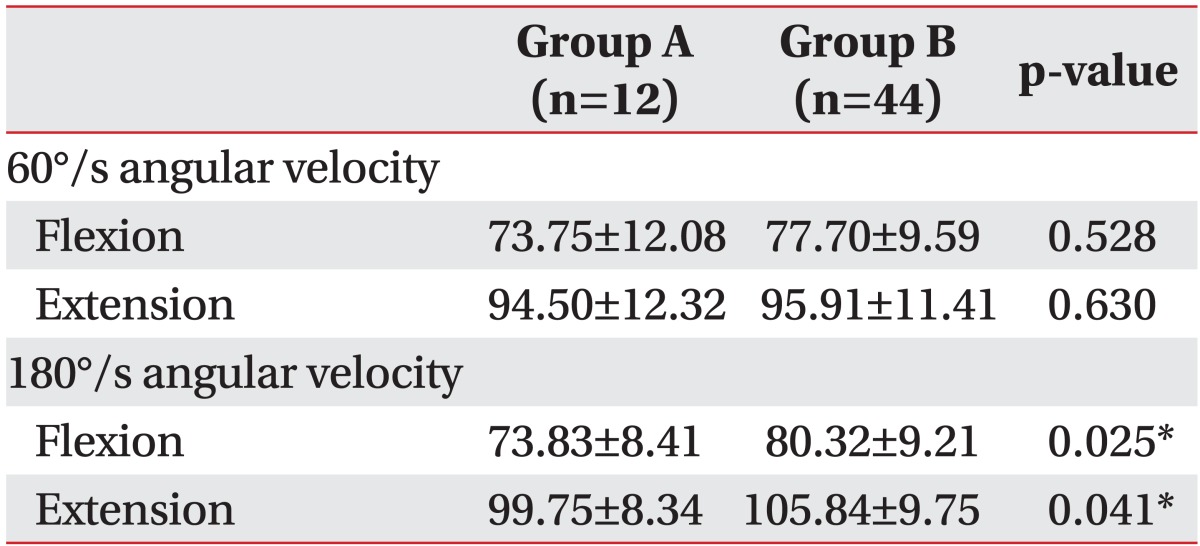

The questionnaires regarding body pain yielded 57 responses; 19 participants (33.33%) were observed to have shoulder pain, which represented the highest frequency of pain among the body parts studied. Shoulder pain was reported by 3 out of 12 subjects (25.00%) in group A and by 19 out of 45 subjects (35.56%) in group B. With regard to the degree of shoulder pain, the related mean VAS score was 4.67±3.51 in group A and 3.5±1.93 in group B; however, the difference in these values was not statistically significant. Although the proportion of subjects who reported shoulder pain was lower in group A than in group B, the degree of shoulder pain was higher in group A, as evidenced by the higher mean VAS scores. In group A, 9 subjects reported of pain in the upper body parts (i.e., neck, upper back, shoulder, elbow, wrist, and finger) and 3 subjects reported of pain in the lower body parts (i.e., lower back, hip, thigh, knee, ankle, and toe), indicating a higher frequency of pain in the upper body compared to lower body parts (ratio of 3:1). In group B, 23 subjects reported of pain in the upper body parts and 22 subjects reported of pain in lower body parts, indicating similar frequencies of pain for the upper and lower body parts (ratio of 1.05:1) (
Table 4). Increasing severity of GIRD was negatively correlated with shoulder pain (CC, -0.22), although this was not statistically significant (p=0.14).
Table 4
Pain frequency and severity
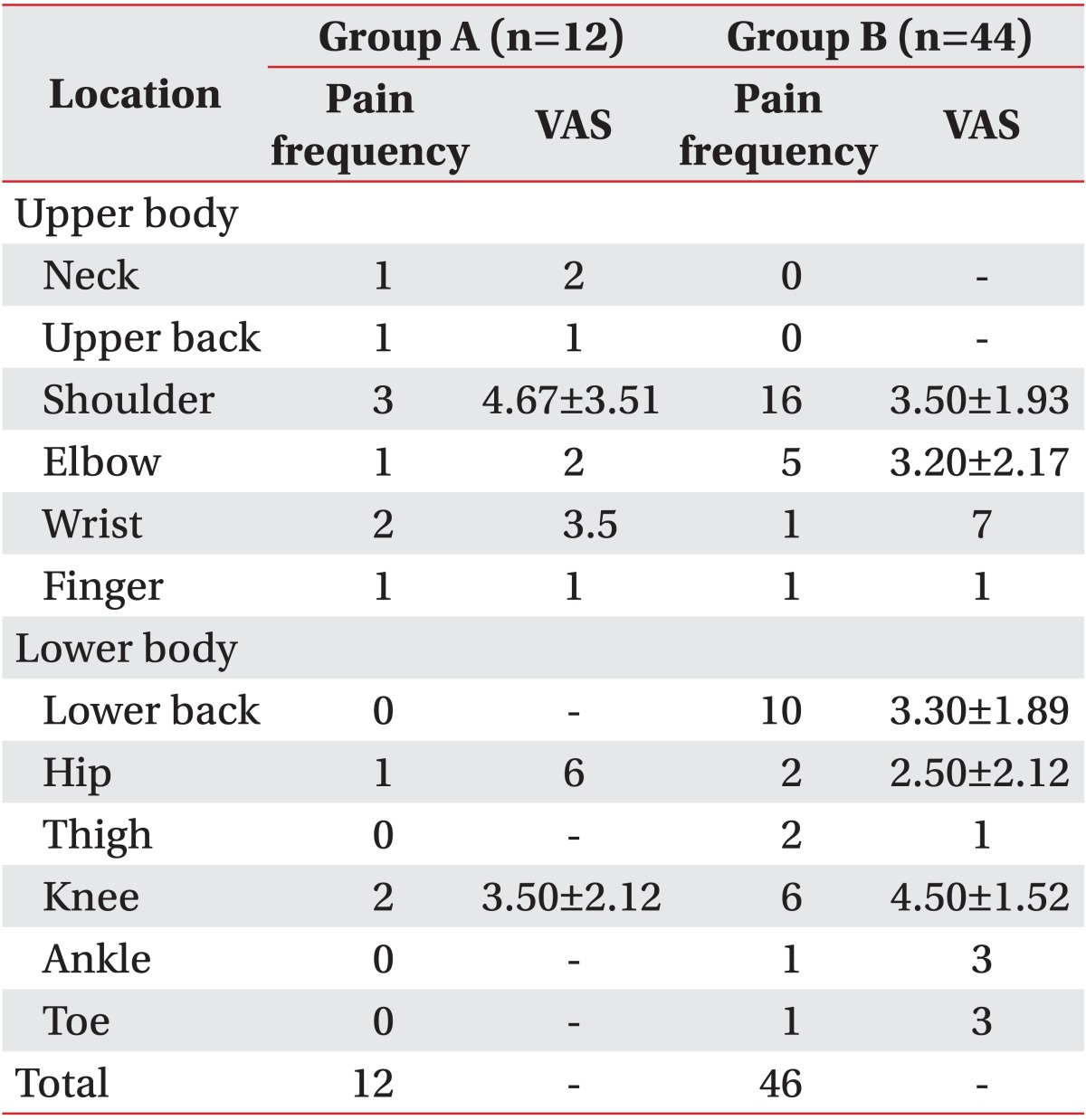

The sum of the scores for the SF-36 responses was 90.45 in group A and 98.78 in group B, indicating a lower quality of life in group A than group B. In particular, a significant difference was observed for body pain (p=0.006), social function (p=0.007), and physical health (p=0.017) (
Table 5). All were negatively correlated with increasing severity of GIRD (CC, -0.25 to -0.13).
Table 5
The mean difference in the quality of life between groups A and B
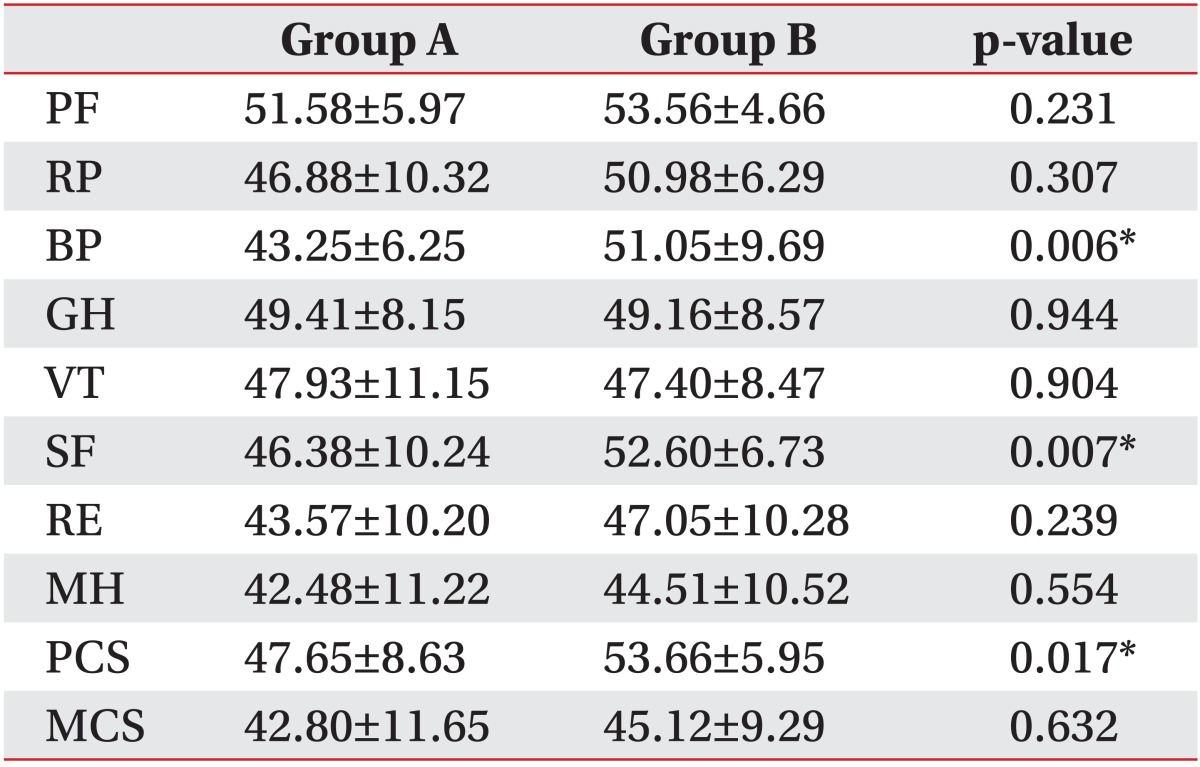

Go to :

DISCUSSION
In this study, a significant relationship was observed between GIRD and pain, isokinetic strength, and the quality of life, among domestic high school male baseball players. Although many international papers have been published regarding GIRD in youth baseball players, only a few papers have been published in Korea. Our study was unique compared to other research studies that involved a comparative analysis between the quality of life and pain in GIRD group.
In this study, we investigated on how GIRD is correlated with isokinetic strength, pain, and the quality of life in teenage male baseball players. In most of the study subjects, the ER ROM of the T-shoulder was greater than that of the NT-shoulder, while the IR ROM of the T-shoulder was lesser than that of the NT-shoulder. Considering that GIRD is a shoulder pathologic risk factor, Burkhart et al. [
14] reported that glenohumeral joint damage increases when the IR ROM deficit of the T-shoulder is ≥20° compared to that of the NT-shoulder. Participants with an IR ROM difference of ≥20° between the T-shoulder and the NT-shoulder were assigned to group A, which accounted for 21.43% of the total subjects in this study. According to the isokinetic strength test, a weaker muscular state was observed in group A compared to group B. Compared to pain in other body parts, the frequency of shoulder pain was the highest (33.93%) among the study subjects. A lower quality of life was also observed in group A compared to group B, according to the evaluations using the SF-36.
Repeated high-velocity pitching causes a change in the stability-mobility relationship of the glenohumeral joint. Characteristically, the ER ROM of the T-shoulder increases, whereas the IR ROM tends to decrease, leading to an increased difference in IR ROM between the T-shoulder and NT shoulder [
4,
5,
6]. An excessively increased ER increases the humeral retroversion, thus causing an IR deficit [
4,
5]. Over time, this pathogenic mechanism leads to the high prevalence of posterior capsular contracture in the T-shoulder. The interface between the humerus and the glenoid gradually shifts in the posterior direction and subsequently leads to a posterior shift of the total arc of motion in the glenohumeral joint [
14,
16]. Consequently, the anterior length of the capsule increases, and the surface area in contact with the anterior-inferior aspect of the glenohumeral joint decreases, which results in an excessive ER [
7]. Therefore, the balance between the IR and ER ROM in the total glenohumeral joint ROM is disrupted [
17,
18]. Wilk et al. [
6] measured the ROM of the T-shoulder in a study of 372 baseball players; in the T-shoulder, the ER ROM was greater and the IR ROM was smaller compared to the NT-shoulder. The results of the present study are compatible with the typical shoulder joint characteristics of baseball players.
In this study, 21.43% of the subjects were included in group A. In a previous study by Shanley et al. [
15], the prevalence of GIRD among baseball players was reported to be nearly 25% (18 out of 72 individuals). Our results are similar to these previous findings. In a study of collegiate baseball pitchers and non-pitching players, Cook et al. [
16] investigated the isokinetic strength of the shoulder flexion and extension and highlighted the importance of shoulder strength balance. The isokinetic strength was closely associated with ROM, and improving the ROM limits was reported to increase joint torque and shoulder performance [
17,
18]. In the isokinetic strength test, the results obtained at an angular velocity of 180°/s are more closely related to the throwing conditions for baseball, where the ball is pitched at a high velocity; this indicates that the limited shoulder ROM may negatively affect performance. In previous studies on GIRD, a considerable amount of research has focused on isokinetic strength of shoulder IR and ER, whereas research on isokinetic strength related to other conditions, such as shoulder flexion or extension, is few. In our study, there was a negative correlation between GIRD and isokinetic strength, which suggests that the isokinetic strength was reduced as GIRD was increased. These findings will enable us to design an effective rehabilitation program for balanced strength, by considering the factors such as muscular imbalance due to shoulder injury.
It has been previously reported that the incidence of glenohumeral joint pain in baseball players was 32%, with overuse being the main cause of such pain [
19,
20]. Surgical treatment for damages in high school pitchers has been reported to have increased from 8% to 24% over the last 10 years [
21]. Noffal [
22] reported that the imbalance of rotator cuff muscles induces muscular dysfunction, thereby creating conditions that easily lead to pain or glenohumeral joint injury. In this study, 33.33% of the subjects reported of shoulder pain, which was similar to previous studies. Interestingly, group A showed a lower frequency of shoulder pain than group B, although the ratio of upper body pain was higher. The throwing motion of the baseball players comprises a series of movements involving the torso, shoulder, elbow, wrist, and fingers. Therefore, the high frequency of upper body pain compared to lower body pain may have been affected by the limited shoulder ROM. Group A had a low quality of life and performance, but the quality of life could be improved through shoulder ROM improvement via an appropriate shoulder joint rehabilitation program. Shanley et al. [
15], who compared the pre- and post-baseball seasons reported that GIRD increased by approximately 7° in the post-season compared to the pre-season values. The present study was conducted in the preseason. Therefore, there is a high probability that the incidence of pain or damage, including the glenohumeral ROM, will increase as the season progresses.
Our study has three limitations. First, because the study subjects had a large amount of team training schedules to prepare for the upcoming high school baseball season, there was a limitation in mustering them for repeated measures of ROM and isokinetic strength. As a mean to reduce bias, the measurements were performed by one doctor of physical rehabilitation in the morning prior to training. According to previous studies [
10,
15], the ROM measurement methods used in this research showed good reliability and validity. Also, the isokinetic measurement using Cybex is an objective testing device commonly used in sports and orthopedic fields in the world. Its reliability and validity are well documented [
23]. Secondly, in the present study, we were unable to measure the isokinetic strength of shoulder IR and ER, due to limited manpower and equipment; therefore, we only evaluated the isokinetic strength of shoulder flexion and extension. Thirdly, this study was conducted in the preseason and the results may not be applicable to the season or post-season conditions [
2,
24].
The glenohumeral joint is easily subjected to damage in baseball players. The American Medical Society for Sports Medicine has recommended monitoring of the development and training intensity in teenage athletes to reduce their risk factors for damages and using appropriate diagnosis and rehabilitation programs in response to the damages [
3]. In this study, GIRD showed a statistically significant and negative correlation with muscle power or isokinetic strength, and it is thought to be related with a decrease in muscle strength and quality of life for male high school baseball players. The group with GIRD was observed to have lower muscle strength, lower quality of life score, and a higher frequency of upper body pain than the non-GIRD group.
Go to :

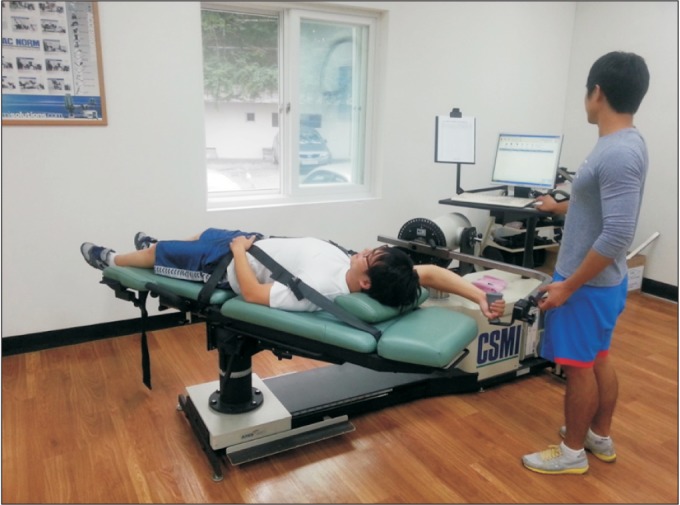




 PDF
PDF ePub
ePub Citation
Citation Print
Print


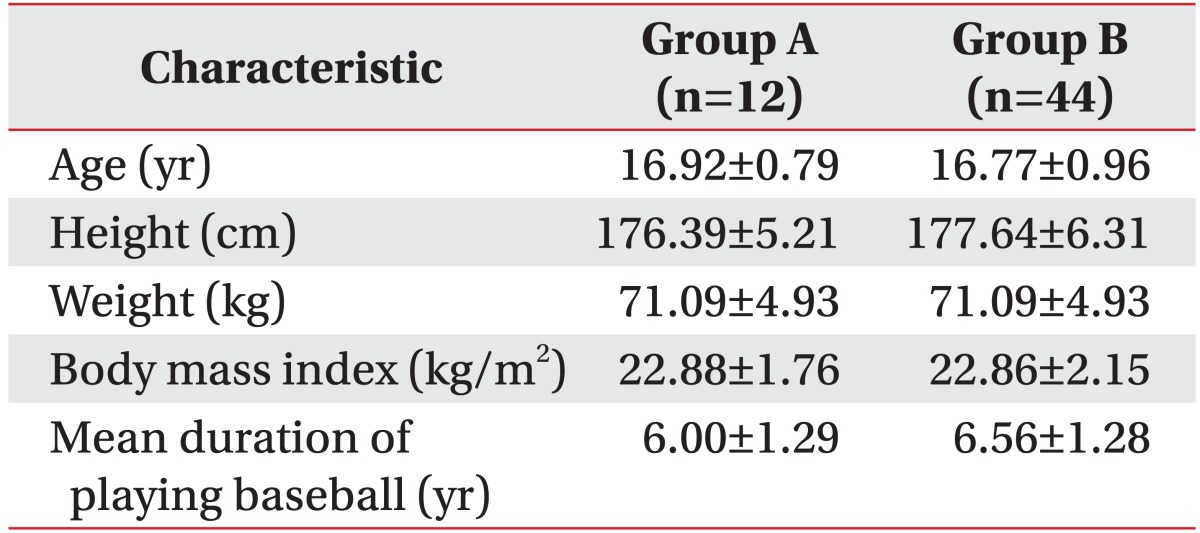




 XML Download
XML Download